Toys
Compiled by Martin Willey
US 1976

"Colorforms Adventure Set No 609".
"Create your own Space 1999 Adventure aboard the Eagle 1 spaceship. Explore the Moon Surface near Moon Base Alpha. Colorforms plastic sticks like magic. No scissors. No paste. Lots of fun!"
Harry and Patricia Kislevitz invented Colorforms in the US in 1951. The concept was based on vinyl pieces which stick to the laminated backing art, but can be repositioned easily. The first Colorforms sets were abstract art, but by 1957 they had licensed Popeye. The company is still producing sets.
Thick card backing (30.5 x 19.5 cm) with foldable 1.5 cm rim around: portrays crude art of cabin (in cut away) of Eagle on lunar surface.
Two 23 x 8 cm boards hold self sticking vinyl stickers to be placed on backing. Stickers in black & another colour (white, yellow, red, blue), including 2 torsos (one uniformed, one suited) of Helena & Koenig, plus various individual arms, helmets, chest packs, stun guns and pairs of legs.
Box 20.5 x 31.5 x 2.5 cm, art of Koenig & Helena floating in space by Eagle (front view, spine on underside); white series logo.
An 11 x 12 cm (folding out to 55 x 12 cm) colour leaflet shows the cover art plus three illustrations of the stickers in use on scenes from the board. "To the parent. Colorforms' toys have a rare educational value. They help a child develop and improve these seven important skills: Finger dexterity, Sense of spatial relationship, Size matching, Building ability, Color sense, Sense of neatness and order, Use of imagination and storytelling ability."
 |
Original artwork in acrylics for the Colorforms game. Cover art is 13" x 20" (33cm x 51cm), board art 13-1/2" x 19" (34cm x 48cm).
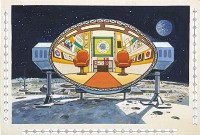

US, UK, Europe 1974
The ViewMaster system for viewing 3D colour images was invented in 1939 by William Gruber for US company Sawyers, which specialized in souvenir photo postcards. They used newly invented 16mm Kodachrome colour film, mounted as seven stereo pairs in a cardboard wheel. Their early sets focussed on scenic attractions, although the first big orders came in World War 2 for the US military to train soldiers in aircraft identification (ironically, Gruber, a German immigrant, was a supporter of the Nazis and was investigated by the FBI). In 1966 Sawyers was acquired by GAF, a film processing company originally formed out of the American subsidiaries of German companies. GAF positioned the ViewMaster as a children's toy, and signed up television licenses. Sawyers had a Belgian plant from the 1960s, and by the 1970s the European and American divisions of GAF were producing specific reels and viewers for their markets, as well as sharing popular content.
Viewmaster offered educational and travel titles as well as TV series and films. Their photographers were allowed to visit studio sets during filming with special 3D cameras. Martin Landau and Barbara Bain had previously been shot in 3D on Mission Impossible (episode The Bunker, 1969). Viewmaster also visited the sets of Batman, Star Trek, Bonanza and in the UK Thunderbirds and UFO.
After a number of take-overs, ViewMaster became part of Mattel (in 1997), under their Fisher-Price brand.
The individual reels are 9 cm diameter circles, each with seven stereo pairs of colour photographs, to be viewed in a Gaf Viewmaster viewer. There are very short descriptions on reels. For the Space: 1999 set, the photos trace the story of "War Games", here titled "The Power Of Fear". The 3 reels are numbered D150 1, D150 2, & D150 3.
There were four different packaging sets. All covers showed photo of Eagle near Earth, with inset photo top right of Koenig & Helena at Eagle control. A yellow banner across top left proclaimed "From the famous TV serial".
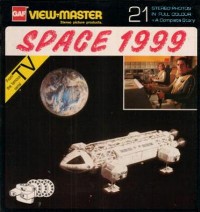 |
Original packaging in the UK was in 20 x 21 cm album. Album folded out into 60 x 21 cm, with three sides describing the story. Each side featured a colour photo and gave a short paragraph for each photo on one reel. Album number ND 150 E. Full details |
Later a blister card was issued in the UK. There was no booklet. Versions for various European languages were also issued in this format.
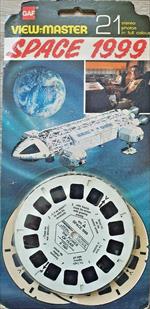
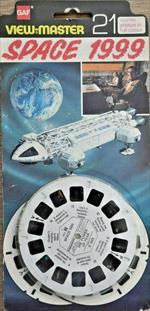
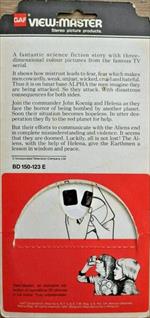
There were 2 small variations of the UK version- the top right text "stereo photos in full colour" is sometimes in a white box.

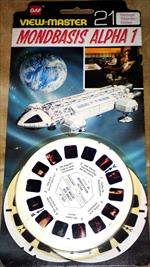

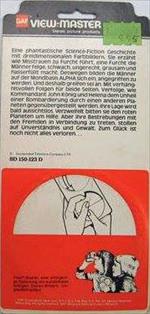
Text on back (BD 150-123 E; other languages are close translations)
A fantastic science fiction story with three-dimensional colour pictures from the famous TV serial.
It shows how mistrust leads to fear, fear which makes men cowardly, weak, unjust, wicked, cruel and hateful. Thus it is on lunar base ALPHA the men imagine they are being attacked. So they attack. With disastrous consequences for both sides.
Join the commander John Koenig and Helena as they face the horror of being bombed by another planet. Soon their situation becomes hopeless. In utter desperation they fly to the red planet for help.
But their efforts to communicate with the Aliens end in complete misunderstanding and violence. It seems that they are doomed. Luckily, all is not lost! The Aliens, with the help of Helena, give the Earthmen a lesson in wisdom and peace,
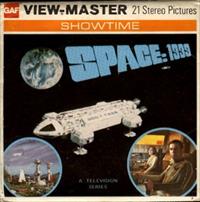
In the US a smaller 10cm x 10cm packet with a booklet was issued. It cost $1.75. Full details
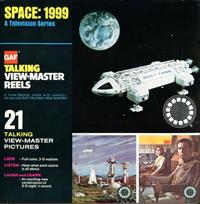
The "Talking Viewmaster" featured an audio disc providing a narration attached to each picture reel. The box (20 x 21 cm) featured the photo of the Eagle by Earth, with two inset photos bottom right (the same images as the BB 451 pack). The small booklet from the BB 451 set (10 x 10cm, 16 pages) with black, white & blue line drawings on most pages was included to explain the story (titled "War Games"). It cost $2.99. Full details
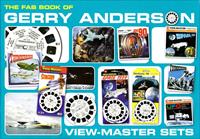
The Fanderson fan club published The FAB Book of Gerry Anderson View-Master Sets in Nov 2011. The Space 1999 View-master sets were covered on pages 36 -45.


UK 1976. "Paperplay No 6"
A 42 x 89 cm sheet of thin card with an orange helmet to be cut out & folded.
UK, US Made in Hong Kong style no. 37-2070 £10.95, $19.95 1976
Illfelder Toy Company began as a company making pencils in Germany in 1856, opening a US branch in 1861. They had a major hit in the 1970s with their "squirmies" toy (a furry "worm" on a string).
According to Broadcasting Magazine they spent $300,000 on TV advertising for this toy in 1976.
15 x 20 x 6 cm chest pack. "A solid-state transistor radio with microphone space signal morse code button and earplug." Features: (as listed on side of pack)
Other side:

uses 4 C size batteries - not included
MICROPHONE - broadcast your voice or sing along with your favorite tunes
SPACE SIGNAL BUTTON - send real morse code messages
EARPLUG - for private listening

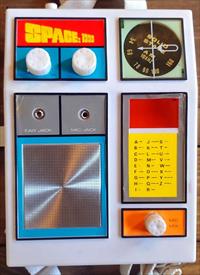
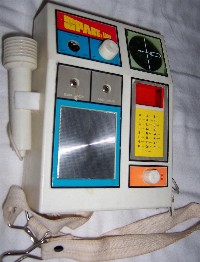
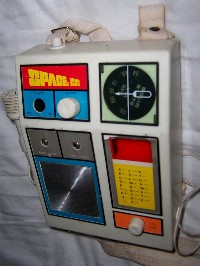
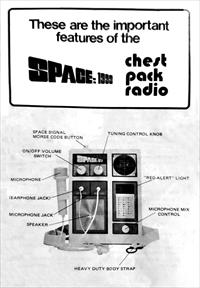
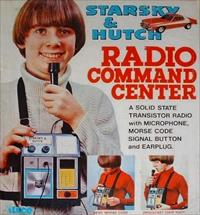
In 1977 this was repackaged as "Starsky & Hutch Radio Command Center", with the logo label replaced and a police badge.
UK 99p 1977. Ref no 5703.
Marx Toys was established by Louis Marx in New York, USA, in 1919. Marx went into sharp decline in the 1960s as Mattel grew dominant. In 1967, the UK brand was sold to a London company, Dunbee-Combex-Marx (DCM); in 1972 Marx US was sold to Quaker Oats, who eventually sold to DCM in 1976. DCM also bought Mattel's UK business in 1973, under the Burbank Toys brand (see Space: 1999 toys) and Hornby in 1972. The company went bankrupt in 1980. Another toy under the Marx brand was a bagatelle.
Red plastic box (6 x 10 x 3.5 cm). Features: "retractable aerial" (6 cm long retractable wire), "ultrasonic space gun" (a rather lethal spring gun set in side of box) firing "laser bullets" (red plastic pellets), an "intergalactic horn" (makes a rasping noise), and "colour code celestial beam" with "multi colour light beam tuner" (a small light with a dial moving colour filters over it).
Uses 1 penlight battery.
Blister pack: 15 x 23 cm card with logo and good art of Eagle & Moon.
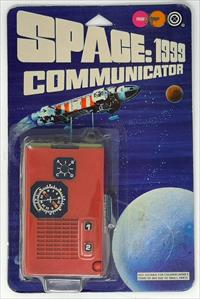


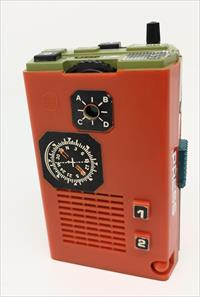
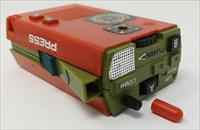
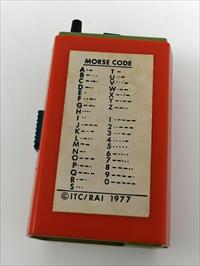
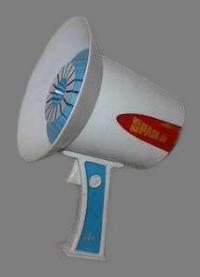
USA 1976 VF-2115
A megaphone. Requires 1 9-volt battery (not included). Two trigger action - voice amplifier/emergency siren. 7.5 inches x 5 inches (19cm x 13cm). Box shows an astronaut using it (spot the scientific flaw!).
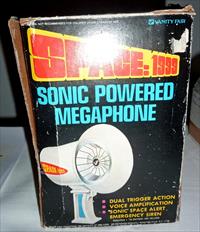



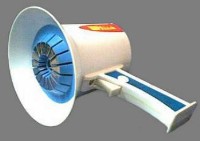
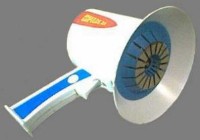
USA Model No. VF-2003
AM wrist radio. Large white leather strap, with a square white plastic radio and black speaker on the face. On one side are three silver metal dials (frequency, volume and on and off). On opposite sides are "Space: 1999" stickers (yellow logo on red background).
The box lists these "Features"
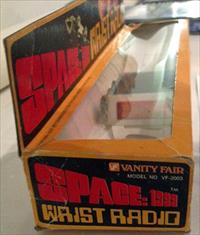

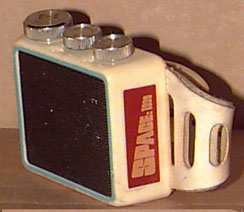
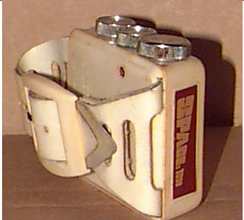
The 1976 Vanity Fair catalogue showing the Megaphone and Wrist Radio (note the MASH wrist radio is identical apart from the logo stickers!). Another Vanity Fair catalogue shows the 007 and Flash Gordon wrist radios are also identical.

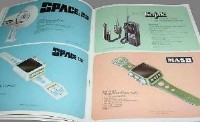

A rare boxed set was sold on ebay in June 2025 for $321
These "pencil tops" are small rubber ornaments put on the ends of pencils. Judging by the R2D2 robot, they are 1977 or later. The box art is an adaptation of the second (1976) UK annual cover art, featuring a rescue Eagle flying over a nuclear mushroom cloud. It was probably not licensed.
US, 1975
Kenner was founded in the US in 1946, and had a number of popular toy lines, including the Give A Show projector (from 1959) and the Spirograph (1966). They were taken over by General Mills in 1967. In the late 1970s they had a huge success with Star Wars figures. In 1991 the company was purchased by Hasbro, and the brand was closed in 2000.
Give A Show was a simple projector, introduced in 1959 and continually reissued with different slides until the end of the 1970s. The slides were in stiff card strips of 7 different 35mm colour cartoon art. Projectors were generally sold with 16 card strips (so 112 slides), often a mix of different TV series.
The subject series were almost always TV cartoons, although there were a few live action shows and even movies, like Star Trek, Six Million Dollar Man and Star Wars.Space: 1999 was one of the 16 slides in a 1975 set. In the UK Chad Valley issued the toy (with Dr Who and several Gerry Anderson series as subjects), but the set with Space: 1999 did not get issued (probably because many of the cartoons were not shown in the UK).


This 1975 set had a picture of Land of the Lost on the cover, and included filmstrips of: Land of the Lost, Fat Albert, Hong Kong Phooey, Far Out Space-Nuts, Bugs Bunny, Josie and the Pussycats, Scooby Doo, Harlem Globetrotters, Pebbles and Bamm-Bamm, Great Grape Ape, Shazam, and Speed Buggy
The Space: 1999 story is named "Operation Asteroid" and has the serial number 686-048-12. The sixth frame shows the Moon with a big chunk missing, probably due to the artist reading misleading ITC publicity.
Images thanks to Gordon Moriguchi